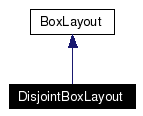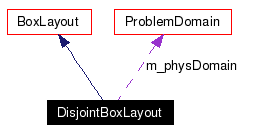
#include <DisjointBoxLayout.H>
Inheritance diagram for DisjointBoxLayout:


Modification functions | |
| virtual void | close () |
| virtual void | deepCopy (const DisjointBoxLayout &a_source) |
| virtual void | deepCopy (const BoxLayout &a_source) |
| virtual void | deepCopy (const BoxLayout &a_source, const ProblemDomain &a_physDomain) |
| void | coarsen (DisjointBoxLayout &output, const DisjointBoxLayout &input, int refinement) |
| void | refine (DisjointBoxLayout &output, const DisjointBoxLayout &input, int refinement) |
Public Member Functions | |
Constructors, destructors, defines | |
| DisjointBoxLayout () | |
| DisjointBoxLayout (const Vector< Box > &a_boxes, const Vector< int > &a_procIDs) | |
| DisjointBoxLayout (const Vector< Box > &a_boxes, const Vector< int > &a_procIDs, const ProblemDomain &a_physDomain) | |
| virtual | ~DisjointBoxLayout () |
| virtual void | define (const Vector< Box > &a_boxes, const Vector< int > &a_procIDs) |
| void | define (BoxLayout &a_layout) |
| void | define (BoxLayout &a_layout, const ProblemDomain &a_physDomain) |
| virtual void | define (const Vector< Box > &a_boxes, const Vector< int > &a_procIDs, const ProblemDomain &a_physDomain) |
| virtual void | define_pd (const Vector< Box > &a_boxes, const Vector< int > &a_procIDs, const ProblemDomain &a_physDomain) |
Checks | |
| bool | isDisjoint () const |
| bool | checkPeriodic (const ProblemDomain &a_domain) const |
| bool | checkDomains (const DisjointBoxLayout &a_dbl) const |
Protected Member Functions | |
| const ProblemDomain & | physDomain () const |
Friends | |
| class | Copier |
Neighbor functions | |
| void | adjCellLo (DisjointBoxLayout &a_output, const DisjointBoxLayout &a_input, int a_dir, int a_len=1) |
| void | adjCellHi (DisjointBoxLayout &a_output, const DisjointBoxLayout &a_input, int a_dir, int a_len=1) |
DisjointBoxLayout is-a BoxLayout that has a concept of disjointedness of the boxes. DisjointBoxLayout is only different from BoxLayout in that it has a method isDisjoint(). DisjointBoxLayouts also have a ProblemDomain member to ensure disjointness in the case of periodic boundary conditions, among other things.
|
|
Construct BoxLayout with no boxes. |
|
||||||||||||
|
Construct from a Vector of Boxes and optionally a Vector of processor assignments. If the processor assignment Vector is present, it must be either zero-length or the same length as the Box Vector. On exit, the DisjointBoxLayout will be closed. |
|
||||||||||||||||
|
Construct from a Vector of Boxes and optionally a Vector of processor assignments. If the processor assignment Vector is present, it must be either zero-length or the same length as the Box Vector. On exit, the DisjointBoxLayout will be closed. |
|
|
Ref-counted destruction. Once the last reference to the implementation of this class is destroyed, the data members are cleaned up. |
|
|
Performs problem domain check when we don't have direct access to a problemDomain.
Returns |
|
|
Checks to see that problem domains are compatible. To be compatible:
There are no checks in non-periodic directions, since DisjointBoxLayouts don't care about physical domains except in the periodic case. |
|
|
Mark this DisjointBoxLayout as complete and unchangeable. Reimplemented from BoxLayout. |
|
||||||||||||
|
Create new open DisjointBoxLayout with copied data. Checks that the source BoxLayout isDisjoint, throws an error if it is not. Otherwise, same as BoxLayout::deepCopy. |
|
|
Create new open DisjointBoxLayout with copied data. Checks that the source BoxLayout isDisjoint, throws an error if it is not. Otherwise, same as BoxLayout::deepCopy. Reimplemented from BoxLayout. |
|
|
Create new open DisjointBoxLayout with copied data. Doesn't check for disjointness, since a_source is already guaranteed to be disjoint. Also copies problem domain info. |
|
||||||||||||||||
|
Define this DisjointBoxLayout from a Vector of Boxes. This is a wrapper for a call to BoxLayout::define, required because DisjointBoxLayout::define is overloaded and the compiler will not look into the base class for name resolution. |
|
||||||||||||
|
Shallow define. Only way to promote a BoxLayout. If BoxLayout has been closed, then this method checks isDisjoint and throws an error if not disjoint. If a_layout is disjoint, then this object becomes a closed DisjointBoxLayout object. |
|
|
Shallow define. Only way to promote a BoxLayout. If BoxLayout has been closed, then this method checks isDisjoint and throws an error if not disjoint. If a_layout is disjoint, then this object becomes a closed DisjointBoxLayout object. |
|
||||||||||||
|
Define this DisjointBoxLayout from a Vector of Boxes. This is a wrapper for a call to BoxLayout::define, required because DisjointBoxLayout::define is overloaded and the compiler will not look into the base class for name resolution. Reimplemented from BoxLayout. |
|
||||||||||||||||
|
Define this DisjointBoxLayout from a Vector of Boxes. Same as define. |
|
|
Returns The Disjoint testing algorithm assumes that the boxes are CELL-Centered boxes. We can expand the algorithm when someone needs it. bvs |
|
|
|
|
||||||||||||||||||||
|
Returns the set of boxes which result from calling Box::adjCellHi on each box in input. Output must be open, will be closed upon exiting this function. |
|
||||||||||||||||||||
|
Returns the set of boxes which you get from calling Box::adjCellLo on each box in input. Output must be open, is closed upon exit from this function. |
|
||||||||||||||||
|
Coarsen a DisjointBoxLayout:
output is first deepCopy'ed from input, then coarsen(refinement) is called on each box of output. output returns from this function closed. LayoutIterators from input and output can perform interchangeably. |
|
|
|
|
||||||||||||||||
|
Refine a DisjointBoxLayout:
output is first deepCopy'ed from input, then refine(refinement) is called on each box of output. output returns from this function closed. LayoutIterators from input and output can perform interchangeably. |
 1.4.1
1.4.1